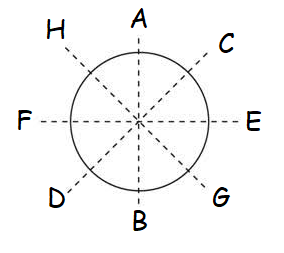How Many Lines of Symmetry does a Circle Have
Introduction
When one shape is moved, rotated, or flipped, the other shape stays the same. This is known as symmetry in mathematics. When something lacks symmetry, it is referred to as being asymmetrical. The concept of symmetry is frequently applied in geometry. Let's acknowledge more to get a concrete answer.
Definition of Symmetry
If a shape can be divided into two additional identical pieces and arranged in an orderly manner, it is said to be symmetrical. If you are instructed to cut out a "heart" from a piece of paper, for instance, you only need to fold the paper, draw one-half of the heart at the fold, and cut it out to discover that the other half exactly matches the first half. A good example of symmetry is the heart that was carved out.
Patterns can be symmetrical. When two halves of an object are balanced and proportionately similar, one half is the mirror image of the other. In daily life, in art, and in architecture, symmetrical objects are all around us.
Line of Symmetry
A line of symmetry divides an object into two identical parts. The circle in this case can be folded into two identical halves along the diameter. When a figure is folded in half along its symmetry axis, the two halves perfectly match one another. This line of symmetry is known as the axis of symmetry.
Symmetry in a Circle
Any diameter of a circle exhibits symmetry. When we say a circle is symmetrical, we mean that any of its diameters can be used to divide it into two identical parts. It is said to have rotational symmetry when a figure is rotated around its centre point and maintains its original appearance. A circle has rotational symmetry. The symmetry in a circle has an infinitely long order. The circle will always be symmetrical around its diameter, regardless of how much we rotate it about its centre or about the diameter.

Conclusion
Since there are an infinite number of lines that pass through the centre, a circle's line of symmetry is its diameter, and there are an infinite number of diameters that a circle can have. There are therefore an infinite number of symmetry lines in a circle.
Frequently Asked Questions (FAQs)
We know that each angle in an equilateral triangle is 60°. When we multiply six equilateral triangles by 60°, it creates a circle figure, and we get 6 × 60 = 360°. Hence the circle is 360 and not 365.
When irregular shapes or objects with irregular figures are divided into two equal parts, they aren't symmetrical, which means those two equal parts aren't mirrored images of each other hence such shapes and objects are termed asymmetric. Some examples of asymmetric shapes are a scalene triangle, a parallelogram, and a trapezium.
There are three types of circles, and they are as follows:
Tangent Circles: when two or more circles intersect each other at one point, then these circles are termed Tangent Circles
Concentric Circles: when two or more circles have the same centre but different radii, then such circles can be called Concentric Circles
Congruent Circles: when two or more circles have the same radii but different centres, these Circles are termed Congruent Circles.
The equilateral triangle has three lines of symmetry.
The line that passes through the centre of the circle divides the circle into two equal parts hence that line can be called the line of symmetry of a circle. Also, the line which passes through the circle's centre can be called the circle's diameter. As the circle has an infinite number of diameters, hence the circle has an infinite number of lines of symmetry.
Applications for Admissions are open.
As per latest syllabus. Physics formulas, equations, & laws of class 11 & 12th chapters
JEE Main Important Chemistry formulas
Get nowAs per latest syllabus. Chemistry formulas, equations, & laws of class 11 & 12th chapters
JEE Main high scoring chapters and topics
Get nowAs per latest 2024 syllabus. Study 40% syllabus and score upto 100% marks in JEE
JEE Main Important Mathematics Formulas
Get nowAs per latest syllabus. Maths formulas, equations, & theorems of class 11 & 12th chapters